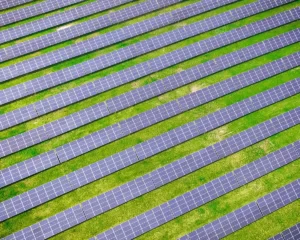Climate change is becoming more of a problem because too much carbon is being released into the atmosphere. Because of this, many countries are looking for clean energy alternatives to fossil fuels.
Solar has been one of the most expensive ways to get clean energy, but prices have been going down. However, taking into account the pros and cons, and with prices expected to continue to fall, the future of solar energy looks quite promising.
The pros of solar energy include that it is a sustainable alternative to fossil fuels and has a low impact on the environment and the potential for any country to produce it. The cons are that it only produces energy when the sun shines, it requires a significant amount of land, and certain solar technologies require rare materials.
In a Nutshell
- The high level of carbon emissions is the cause of climate change, which is a major issue.
- To cut carbon emissions, clean energy alternatives like solar are being sought after.
- Sustainability, minimal environmental effect, and the potential for energy independence are all benefits of solar energy.
- However, it also has drawbacks like irregularity, extensive land use, and a lack of necessary resources.
- Technology for solar energy is getting more affordable and competitive.
- Large solar power installations include Solar Star in the United States and the Bhadla solar park in India.
- Two of the renewable energy sources with the fastest growth rates are solar and wind power.
Advantages of Solar Energy
Sustainability
The advantage of solar energy is that it is a sustainable alternative to fossil fuels. While fossil fuels have an expiration date that may be fast approaching, the sun is likely to continue to exist for at least a few billion years.
Low Environmental Impact
Solar energy has a substantially lower impact on the environment than fossil fuels. It doesn’t contribute much to greenhouse gas emissions because it doesn’t need to burn any fuel.
Also, depending on the technology used, concentrating solar thermal power (CSP) plants aren’t very good at using water efficiently. However, the right technology can make them much more efficient, and photovoltaic (PV) solar cells don’t need water to make electricity.
Solar energy technology is becoming an increasingly cost competitive alternative to fossil fuels, although it remains somewhat expensive in certain markets.
Energy Independence
Because the sun shines all over the planet, it makes every country a potential energy producer, allowing for greater energy independence and security. Solar energy not only promises to bring national security and independence; solar panels can be installed on individual homes, providing energy that does not depend on being connected to a major power grid.
Disadvantages of Solar Energy
Intermittency
One of the biggest problems with solar power technology is that power is only generated while the sun is shining. That means that night and cloudy days can interrupt supply. The shortages created by this disruption would not be a problem if there were cheap ways to store energy, as extremely sunny periods can generate excess capacity. As global solar power capacity continues to increase, countries such as Japan and other world leaders in solar power technology are focusing on developing suitable energy storage to address this problem.
Land Use
Another concern is that solar energy may take up a significant amount of land and cause land degradation or loss of wildlife habitat. Although solar PV systems can be attached to existing structures, larger scale PV systems can require between 3.5 and 10 acres per megawatt and CSP installations between 4 and 16.5 acres per megawatt. However, the impact can be reduced by siting installations in low grade areas or along existing transmission and transmission corridors.
Shortage of Materials
Some solar technologies require rare materials for their production. However, this is primarily a problem for photovoltaic technology rather than CSP technology. Moreover, it is not so much the lack of known reserves as the inability of current production to meet future demand: Many of the rare materials are leftovers from other processes and are not mined on their own. Recycling photovoltaic materials and making progress in nanotechnology that makes solar cells work better could help increase supply. Finding materials that are similar but easier to find could also play a role.
An Environmental Drawback
The only environmental drawback to solar technology is that it contains many of the same hazardous materials as electronics. As solar energy becomes a more popular energy source, the problem of hazardous waste disposal becomes an additional challenge. However, assuming the problem of proper disposal is solved, the reduced greenhouse gas emissions offered by solar energy make it an attractive alternative to fossil fuels.
- Lower impact on the environment
- Helps countries become more energy independent
- Cost effective
- Reduced impact on the environment
- Helping countries become more energy independent
- Profitable
- Occupies large tracts of land
- The technology is not yet widespread
- Can still harm the environment
173,000
The approximate number of terawatts of solar energy shining on the Earth each day: 10,000 times the world’s daily energy consumption.
Examples of Solar Energy
The world’s largest solar power plant is located in Rajasthan, India. The Bhadla solar farm, completed in April 2020, boasts impressive statistics. The plant occupies 10,000 acres and has an installed capacity of 2,245 megawatts. Total investment in the project is estimated at around $1.4 billion.
The largest solar farm in the United States is known as Solar Star, near Rosamond (California). The plant consists of two separate facilities called Solar Star 1 and Solar Star 2, with respective capacities of 314MW and 265MW. Like the Indian plant, the site was chosen for its high sun exposure and low rainfall.
Solar Versus Wind Energy
Both wind and solar power are two of the fastest growing renewable energy sources. Both energy sources contribute to reducing pollution and offer alternatives to fossil fuels, although there are notable differences between them.
Turbines that power wind energy are less harmful to the environment than solar panels. They also produce more electricity than solar panels and can be installed offshore. Unlike solar, wind energy can be harnessed both day and night. However, wind is an unpredictable source of energy. Turbines are also quite noisy and, like solar panels, require a lot of land space, so they do not make sense in densely populated areas.
Ultimately, solar panels are the most powerful and predictable source of energy. They require less space, are less noisy and can be installed on rooftops, etc. in densely populated areas.
Wrap Up
In conclusion, solar energy is viewed as a promising replacement for fossil fuels due to its sustainability, little negative effects on the environment, independence from external sources of energy, and affordability. However, it also faces difficulties like sporadicness, land use, a lack of supplies, and the disposal of hazardous waste. Despite this, the usage of solar energy is expanding and is anticipated to become a more appealing choice in the future as technology progresses.
India and the US are home to the two biggest solar power facilities in the world, and investments in the industry are still rising. Solar energy has significant benefits and drawbacks in comparison to wind energy, making both renewable energy sources crucial for the move away from fossil fuels.
FAQs

Photovoltaic cells are used to collect sunlight and transform it into electricity to create solar energy.
Solar energy works by converting sunlight into direct current (DC) power using photovoltaic (PV) cells. This DC electricity is then transformed into alternating current (AC), which may be used in homes and businesses.
Solar energy is a trustworthy source of energy. Solar panels can last up to 25 years with proper care. In addition, solar panels are now more reliable and efficient thanks to technical advancements.
Depending on the size of the installation, the kind of panels used, and local laws, the price of solar panels might vary significantly. A solar panel system might cost anywhere from $10,000 to $40,000 on average.
Solar energy does indeed emit no greenhouse gases and is a clean, renewable energy source. It is a sustainable substitute for conventional fossil fuels.
Yes, a lot of governments provide tax breaks and rebates as well as other incentives and subsidies for solar energy installations. The initial installation cost may be partially offset by these subsidies, lowering the cost of solar energy for users.
Lower energy prices, less reliance on fossil fuels, a more reliable energy source, and a smaller carbon impact are all benefits of solar energy. Solar energy can also promote energy independence and job growth in the expanding clean energy industry.
Solar energy may be used anywhere, albeit the amount of sunshine varies depending on where you are. It might be necessary to install more panels or utilize more advanced technologies in areas with less sunlight.
A solar energy system installation can raise a home’s value, yes. Studies show that houses with solar panels typically sell for 4 5% more than houses without them. Additionally, because more and more purchasers are searching for energy efficient homes, they also have a tendency to sell more quickly.
Article sources
At Capital Maniacs, we are committed to providing accurate and reliable information on a wide range of financial topics. In order to achieve this, we rely on the use of primary sources and corroborated secondary sources to support the content of our articles.
Primary sources, such as financial statements and government reports, provide firsthand evidence of financial events and trends. By using primary sources, we are able to directly reference information provided by the organizations and individuals involved in these events.
Secondary sources, such as financial analysis and commentary, interpret and analyze primary sources. While these sources can be useful for providing context and background information, it is important to use corroborated sources in order to ensure the accuracy and reliability of the information we present.
We take pride in properly citing all of our sources, both primary and secondary, in order to give credit to the original authors and to allow our readers to verify the information for themselves. We appreciate your trust in our website and are committed to upholding the highest standards of financial journalism.
- Britannica – Solar Energy
- Union of Concerned Scientists – Environmental Impacts of Solar Power
- Massachusetts Institute of Technology – Shining Brightly
- NS Energy – Bhadla Solar Park, Rajasthan
- SEIA – Solar Energy



















